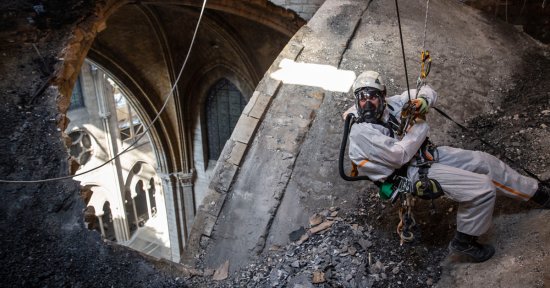
Nearly three months after a fire gutted Notre Dame Cathedral in Paris, the building’s chief architect has warned that there is still a risk that the historic building’s ceiling arches might yet collapse, causing severe structural damage.
“The risk is that all the vaults up there fall. It is that simple,” says Philippe Villeneuve, chief architect of Notre Dame, who led TIME on a tour of the fire-ravaged cathedral. “For the moment we do not know because no one has gone to see them, because you cannot go and see them.”
[video id=v4JtRm4h ]The man responsible for overseeing the reconstruction of Notre Dame says the risks of a catastrophic collapse are small but that the true extent of the damage will not be known until at least the end of the year. Until then, it will remain a triage site.
Those assessing Notre Dame’s damage are working to a tight deadline: President Emmanuel Macron has declared that the building should be rebuilt within five years. But Villeneuve says there remain some deeply worrying unknowns about what state Notre Dame is in, especially as the building’s interior is now open to the elements. “We do not know if there are fissures or fractures,” he says.



In early July, Villeneuve took TIME to the rooftop where the fire began in April 15, the first journalists to visit the spot. To reach the site, we mounted the ancient spiral stone steps leading to what remains of Notre Dame’s roof, an area that has remained off-limits to outsiders since the fire began on the upper levels of the Parisian cathedral.
The scene atop the almost 900-year-old building is dismaying. The roof’s frame is now just a giant tangle of molten lead, twisted and bent like spaghetti in the fire. The roof itself is a gaping hole with nothing between it and the nave 226 feet below. Plastic sheeting and netting cover parts of the hole, while other parts remain exposed to rainfall and the high temperatures that France has experienced in recent weeks.

It was up on roof level that a spark from an unknown source ignited a fire around sunset on April 15, whipping within minutes through the roof. The 300-foot wooden spire, mounted about 150 years ago, tilted in the blaze and then crashed in pieces through the roof, bringing down with it the vaulted oak ceiling that Medieval craftsman built by hand in the 13th century.
Now, for the next several months, the task will be dealing with the impact from shocks that occurred those first few hours the night of April 15—not only from the flames, but from the collapsing wood and stone, as well as the high-pressure water hoses pumped into the cathedral to put out the blaze; it took fire fighters nine hours to douse the fire.


“After the initial heat shock, there was the shock of cold water that probably made reactions in the 800-year-old mortar, and the shocks of falling stone,” Villeneuve says. What the full impact was, he says, “it is hard to know.”
For now, it is deemed too risky for humans to work inside the cathedral, since any manipulation or heavy pressure could cause further damage. That is why the architects and engineers have been unable as yet to examine the damage in fine detail. But Villeneuve says sensors installed the day after the fire have so far failed to detect any structural movement that might signal an imminent collapse.



On the July day TIME’s team visited Notre Dame’s rooftop, a mammoth crane on the north side hoisted a seven-ton wooden frame up to the roof level, built exactly to fit on the cathedral. Another frame had been lifted on the south side the day before.
These frames are aimed at stabilizing the building enough so workers can begin moving around the damaged upper levels, and examining much more closely the damage the fire wrought on the vaults and flying buttresses.


Within the interior of the cathedral, remote-controlled earth-moving vehicles venture into the center of the nave, where the spire fell, to pick out pieces one by one from a large pile of charred debris. But it will take weeks more before the pile is removed.
Each piece—including burned bits of the spire and roof, as well as busts and stonework—is being tagged and catalogued under a tent in the front yard of Notre Dame. The rows of rescued pieces are separated by stonework and charred wood, including the spire, one of the most iconic landmarks of Paris. “We know the spire is there but we will not try to find it,” Villeneuve says. “It is completely shattered.”



French President Emmanuel Macron declared the day after the fire that Notre Dame needed to be reopened within five years, apparently with an eye on the Summer Olympics in Paris in 2024. But the tight time frame faces challenges, however, including a fierce debate over whether to consider innovative designs for the rebuilding—as Prime Minister Edouard Philippe has suggested—or whether Notre Dame should be rebuilt exactly as the Medieval architects envisioned, as many French traditional politicians have argued.
Those decisions are still months away, and Villeneuve says for now the priority is ensuring the cathedral is ready to be rebuilt. “For the moment I am in the restoration, stabilization and rescue phase,” he says. “Then will come the time for studying.”

Vivienne Walt is a Paris-based correspondent. Follow her on Twitter @vivwalt.
Patrick Zachmann is a photographer with Magnum Photos. Follow him on Instagram @pzachmann.
Andrew Katz, who edited this photo essay, is TIME’s Deputy Director of Photography. Follow him on Instagram @katzandrew.